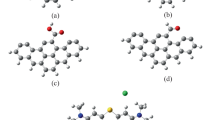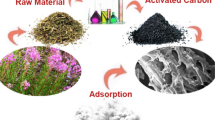Abstract
Humins, the solid wastes from biomass acid hydrolysis, were value-added applied for activated carbon production through the phosphoric acid activation method with pyrolysis temperature ranging from 300 to 700 °C. Studies on structure and properties found that pyrolysis temperature is a key factor affecting pore formation of activated carbons. A good yield of 51.4 wt%, high BET surface area of 2375 m2/g, Barrett-Joyner-Halenda (BJH) pore volume of 0.88 cm3/g, and an excellent Langmuir adsorption capacity of 1125 mg/g on methylene blue (MB) were obtained under the preferred temperature of 400 °C (AC400). The adsorption of MB was well explained by the pseudo-second-order kinetic model, and the adsorption behavior complied with Langmuir isotherm model. Dichloromethane (DCM) was found a most effective extractant in AC400 regeneration by using Soxhlet apparatus. A comparable adsorption capacity of 680 mg/g MB was maintained for the fifth reusing of the AC400, illustrating the application potential of humins valorization for biomass residues recycling industry.








Similar content being viewed by others
References
Kang S, Fu J, Zhang G (2018a) From lignocellulosic biomass to levulinic acid: a review on acid-catalyzed hydrolysis. Renew Sust Energ Rev 94:340–362
Rout PK, Nannaware AD, Prakash O, Kalra A, Rajasekharan R (2016) Synthesis of hydroxymethylfurfural from cellulose using green processes: a promising biochemical and biofuel feedstock. Chem Eng Sci 142:318–346
Bozell JJ (2010) Connecting biomass and petroleum processing with a chemical bridge. Science 329:522–523
Galletti AMR, Antonetti C, De Luise V, Licursi D, Nassi N (2012) Levulinic acid production from waste biomass. BioResour 7:1824–1835
Kang S, Yu J (2016) An intensified reaction technology for high levulinic acid concentration from lignocellulosic biomass. Biomass Bioenergy 95:214–220
Patil SK, Heltzel J, Lund CR (2012) Comparison of structural features of humins formed catalytically from glucose, fructose, and 5-hydroxymethylfurfuraldehyde. Energ Fuel 26:5281–5293
van Zandvoort I, Wang Y, Rasrendra CB, van Eck ER, Bruijnincx PC, Heeres HJ, Weckhuysen BM (2013) Formation, molecular structure, and morphology of humins in biomass conversion: influence of feedstock and processing conditions. ChemSusChem 6:1745–1758
Ordomsky V, Sushkevich V, Schouten J, Van Der Schaaf J, Nijhuis T (2013) Glucose dehydration to 5-hydroxymethylfurfural over phosphate catalysts. J Catal 300:37–46
Sumerskii I, Krutov S, Zarubin MY (2010) Humin-like substances formed under the conditions of industrial hydrolysis of wood. Russian J Appl Chem 83:320–327
Weingarten R, Conner WC, Huber GW (2012) Production of levulinic acid from cellulose by hydrothermal decomposition combined with aqueous phase dehydration with a solid acid catalyst. Energy Environ Sci 5:7559–7574
Rasrendra CB, Windt M, Wang Y, Adisasmito S, Makertihartha IGBN, van Eck ERH, Meier D, Heeres HJ (2013) Experimental studies on the pyrolysis of humins from the acid-catalysed dehydration of c6-sugars. J Anal Appl Pyrol 104:299–307
Hoang TM, Lefferts L, Seshan K (2013) Valorization of humin-based byproducts from biomass processing-a route to sustainable hydrogen. Chemsuschem 6:1651–1658
Kang S, Zhang G, Yang Q, Tu J, Guo X, Qin FG, Xu Y (2016) A new technology for utilization of biomass hydrolysis residual humins for acetic acid production. BioResour 11:9496–9505
Pin JM, Guigo N, Mija A, Vincent L, Sbirrazzuoli N, van der Waal J, de Jong E (2014) Valorization of biorefinery side-stream products: combination of humins with polyfurfuryl alcohol for composite elaboration. ACS Sustain Chem Eng 2:2182–2190
Kang S, Fu J, Zhang G, Zhang W, Yin H, Xu Y (2017) Synthesis of humin-phenol-formaldehyde adhesive. Polymers 9(8):373
Girisuta B, Janssen L, Heeres H (2006) A kinetic study on the decomposition of 5-hydroxymethylfurfural into levulinic acid. Green Chem 8:701–709
Girisuta B, Janssen L, Heeres H (2007) Kinetic study on the acid-catalyzed hydrolysis of cellulose to levulinic acid. Ind Eng Chem Res 46:1696–1708
Kang S, Fu J, Deng Z, Jiang S, Zhong G, Xu Y, Guo J, Zhou J (2018b) Valorization of biomass hydrolysis waste: activated carbon from humins as exceptional sorbent for wastewater treatment. Sustainability 10:1795
Zheng W, Bao W, Gu B, He X, Leng L (2007) Carbon concentration and its characteristics in terrestrial higher plants. Chin J Ecol 26:307–313
Ioannidou O, Zabaniotou A (2007) Agricultural residues as precursors for activated carbon production—a review. Renew Sust Energ Rev 11:1966–2005
Guan W, Xu G, Duan J, Shi S (2018) Acetone–butanol–ethanol production from fermentation of hot-water-extracted hemicellulose hydrolysate of pulping woods. Ind Eng Chem Res 57:775–783
Altenor S, Carene B, Emmanuel E, Lambert J, Ehrhardt JJ, Gaspard S (2009) Adsorption studies of methylene blue and phenol onto vetiver roots activated carbon prepared by chemical activation. J Hazardous Mater 165:1029–1039
Jamion N, Hashim I (2017) Preparation of activated carbon from tamarind seeds and methylene bule (MB) removal. J Fundamen Appl Sci 9:102–114
Kang S, Li X, Fan J, Chang J (2012) Characterization of hydrochars produced by hydrothermal carbonization of lignin, cellulose, d-xylose, and wood meal. Ind Eng Chem Re 51:9023–9031
Hameed B, Rahman A (2008) Removal of phenol from aqueous solutions by adsorption onto activated carbon prepared from biomass material. J Hazardous Mater 160:576–581
Solum MS, Pugmire RJ, Jagtoyen M, Derbyshire F (1995) Evolution of carbon structure in chemically activated wood. Carbon 33:1247–1254
Jagtoyen M, Derbyshire F (1998) Activated carbons from yellow poplar and white oak by H3PO4 activation. Carbon 36:1085–1097
Daletou MK, Geormezi M, Vogli E, Voyiatzis GA, Neophytides SG (2014) The interaction of H3PO4 and steam with PBI and TPS polymeric membranes. A TGA and Raman study. J Mater Chem A 2:1117–1127
Kang S, Yu J (2015) A gasoline-grade biofuel formed from renewable polyhydroxybutyrate on solid phosphoric acid. Fuel 160:282–290
Wang X, Huang A, Zhong S, Pan Y, Tian Y (2015) Facile preparation of mesoporous carbon microspheres containing nickel nanoparticle and dye adsorption behavior. Sci Adv Mater 7:43–49
Dehghani MH, Mostofi M, Alimohammadi M, McKay G, Yetilmezsoy K, Albadarin AB, Heibati B, AlGhouti M, Mubarak N, Sahu J (2016) High-performance removal of toxic phenol by single-walled and multi-walled carbon nanotubes: kinetics, adsorption, mechanism and optimization studies. J Ind Eng Chem 35:63–74
Vargas AM, Cazetta AL, Kunit MH, Silva TL, Almeida VC (2011) Adsorption of methylene blue on activated carbon produced from flamboyant pods (Delonix regia): study of adsorption isotherms and kinetic models. Chem Eng J 168:722–730
Gürses A, Doğar Ç, Yalçın M, Açıkyıldız M, Bayrak R, Karaca S (2006) The adsorption kinetics of the cationic dye, methylene blue, onto clay. J Hazardous Mater 131:217–228
Al-Ghouti MA, Khraisheh MA, Ahmad MN, Allen S (2009) Adsorption behaviour of methylene blue onto Jordanian diatomite: a kinetic study. J Hazardous Mater 165:589–598
El Qada EN, Allen SJ, Walker GM (2006) Adsorption of methylene blue onto activated carbon produced from steam activated bituminous coal: a study of equilibrium adsorption isotherm. Chem Eng J 124:103–110
Funding
This article was made possible by Grant Number 21606045 from the National Natural Science Foundation of China and by Grant Number 2017A030313084 from the Natural Science Foundation of Guangdong Province of China, and Guangdong Innovation Research Team for Higher Education (2017KCXTD030).
Author information
Authors and Affiliations
Corresponding author
Additional information
Publisher’s Note
Springer Nature remains neutral with regard to jurisdictional claims in published maps and institutional affiliations.
Rights and permissions
About this article
Cite this article
Kang, S., Jiang, S., Peng, Z. et al. Valorization of humins by phosphoric acid activation for activated carbon production. Biomass Conv. Bioref. 8, 889–897 (2018). https://doi.org/10.1007/s13399-018-0329-3
Received:
Revised:
Accepted:
Published:
Issue Date:
DOI: https://doi.org/10.1007/s13399-018-0329-3




